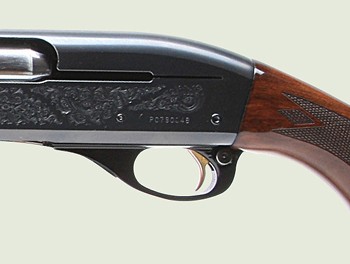Secondhand gun review: Remington 11-87 shotgun

Secondhand gun review: Remington 11-87 shotgun
Manufacturer: Remington
Remington 11-87 shotgun.
It was the famous Model 1100, and it is with us still after nearly 50 years.
Leek had been aided in his task by colleagues James Martin, Charles Morse, Clark Workman and R. P. Kelly.
The team’s first 12-bore examples appeared in American gun shops in 1963, and in Europe shortly afterwards.
Skeet shooters loved them for their fast handling and the ability of the gas operated action to damp recoil.
The gun soon became a favourite world-wide, not just in the competition disciplines but among field shooters as well. In the UK, pigeon shooters loved it.
 A 16-bore version came out in 1964, and 20-bores and .410s in 1969.
A 16-bore version came out in 1964, and 20-bores and .410s in 1969.
A matched pair in .410 and 28-bore appeared in 1970.
Some early 1100’s came into the UK via Germany, and therefore had German proof marks.
But most, as now, have English proof – except for a few brought in by American servicemen years ago and innocently sold on to UK citizens.

In the American fashion, they had no proof marks at all!
Over the years more than four million 1100s have been produced in more versions than it is possible to list.
Then, in 1987, an important variant was launched. It was named the 11-87, and the slightly altered design was claimed to address some of the 1100s few shortcomings.
The 11-87 reached UK shores in 1988, and shooters on this side of the pond were initially a bit disappointed.

The famed Remmie handling was spoiled by an over-weight barrel – I know because I owned one of the first imported. That stovepipe barrel was probably fitted because, at the time, US gun manufacturers were starting to get paranoid about steel shot and possible litigation if a barrel burst.

Be that as it may, a lighter tube was soon introduced in the UK, and the Sporting Clays version handled very nicely.
At one time it was thought that the 11-87 would completely replace the 1100, and the rumour over here in the late 1980s was that the only 1100s produced in future would be 20-bores.

Thankfully either the story was untrue, or Remington changed their minds.
IF BUYING THE OLDER 1100S
Look out for:
– Extractor claws and bolt followers can be a bit fragile.
– Very old guns can develop fatigue cracks in the action at the rear of the bolt handle slot.
– The internal rails on which the bolt runs can wear as sharp as razors
– O-ring seals in the gas mechanism wear out, but are easily replaced.
– Remember these guns function best on full-length 70mm (2.3/4in) cartridges, and may not be tolerant of loads under 28g.
TECH SPEC
Both guns: Conventional gas-fed semi-autos with tubular
magazines in fore-end. Five-shot versions of both guns available.
For Firearms Certificate holders, but most guns take two in the mag tube and one in the chamber. Wood and synthetic stocks available, generally with drops of around 1.1/2in and 2.1/2in at comb and heel respectively.
Some, but not all, spare parts are interchangeable between 1100s and 11/87s.
Spare barrels (not interchangeable between 1100s and 11-87s) fit straight out of the box.
True left-hand versions of most models available, together with a variety of barrel lengths, fixed and multichoke, generally from 26 to 30 inches.
WHAT’S GOOD?
> Classic design.
> Most models handle well.
> Reliable, long-established importer.
WHAT’S BAD?
> Not so ammunition tolerant as some more modern designs.
WHAT TO PAY
> Good second-hand examples of the 11-87 from £500 upwards.
> Second-hand 1100s are generally a little cheaper, but very cheap guns could have fired many thousands of shots.
WEBSITES
> www.edgarbrothers.com for the importer
> www.remington.com for the manufacturer.









